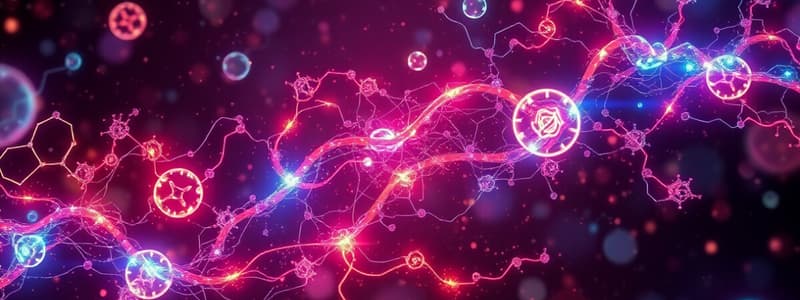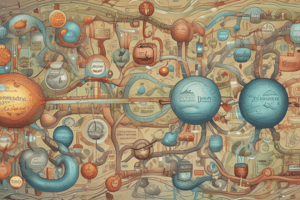Podcast
Questions and Answers
What is the general formula for glucose and its significance in biology?
What is the general formula for glucose and its significance in biology?
(CH2O)n; it serves as a primary source of energy for cells.
Explain the difference between catabolic and anabolic pathways in metabolism.
Explain the difference between catabolic and anabolic pathways in metabolism.
Catabolic pathways release energy by breaking down molecules, while anabolic pathways require energy to build molecules.
How do living organisms adhere to the laws of thermodynamics?
How do living organisms adhere to the laws of thermodynamics?
Living organisms convert energy while obeying the first and second laws of thermodynamics, ensuring energy conservation and increasing entropy.
What role does carbon play in biological molecules?
What role does carbon play in biological molecules?
Define metabolism and its importance in cellular activity.
Define metabolism and its importance in cellular activity.
What is the difference between anabolic and catabolic pathways in terms of energy utilization?
What is the difference between anabolic and catabolic pathways in terms of energy utilization?
Give two examples of anabolic processes.
Give two examples of anabolic processes.
What role does ATP play in metabolic pathways?
What role does ATP play in metabolic pathways?
Why are catabolic pathways important for cellular energy production?
Why are catabolic pathways important for cellular energy production?
How do specialized enzymes contribute to metabolic pathways?
How do specialized enzymes contribute to metabolic pathways?
What does it suggest when researchers find shared metabolic pathways among diverse organisms?
What does it suggest when researchers find shared metabolic pathways among diverse organisms?
Explain the significance of NADH and NADPH in anabolic pathways.
Explain the significance of NADH and NADPH in anabolic pathways.
What is the overall purpose of metabolism in living organisms?
What is the overall purpose of metabolism in living organisms?
What type of bonds link the phosphate and sugar groups in nucleotides during polymerization?
What type of bonds link the phosphate and sugar groups in nucleotides during polymerization?
How do the structures of nucleic acids compare to those of proteins?
How do the structures of nucleic acids compare to those of proteins?
Why do polysaccharides limit the potential for carrying genetic information compared to nucleic acids?
Why do polysaccharides limit the potential for carrying genetic information compared to nucleic acids?
What essential functions do polysaccharides perform in cells?
What essential functions do polysaccharides perform in cells?
What role does energy play in the survival of living organisms?
What role does energy play in the survival of living organisms?
How are the processes of building and breaking down complex molecules categorized in cells?
How are the processes of building and breaking down complex molecules categorized in cells?
What does the evolution of metabolic pathways enable primitive cells to do?
What does the evolution of metabolic pathways enable primitive cells to do?
What is implied by the emergence of new metabolic processes in cells?
What is implied by the emergence of new metabolic processes in cells?
Flashcards are hidden until you start studying
Study Notes
Anabolic Pathways
- Require energy input to synthesize complex molecules from simpler ones.
- Examples:
- Synthesizing sugar from carbon dioxide
- Synthesis of large proteins from amino acids
- Synthesis of new DNA strands from nucleic acid building blocks
- Biosynthetic processes are essential for cell life, occur constantly, and require energy from ATP, NADH, and NADPH.
Catabolic Pathways
- Involve the degradation or breakdown of complex molecules into simpler ones.
- Release energy stored in the bonds of complex molecules.
- Energy released is used to produce ATP, the primary energy currency of the cell.
- Other energy-storing molecules, like fats, are broken down through catabolic reactions to release energy.
Evolution of Organisms
- All branches of life share some of the same metabolic pathways.
- Organisms likely evolved from the same ancient common ancestor.
- Over time, pathways diverged, organisms gained specialized enzymes, and better adapted to their environments.
- All organisms harvest energy from their environment and convert it to ATP for cellular functions.
Subcellular Fractionation
- Mechanically homogenize tissue to break down cell components.
The Chemical Basis of Life
- Carbon is the central atom of biological molecules.
- Carbon binds with oxygen, hydrogen, and nitrogen to form molecules essential for cellular function.
- Cells perform life functions through chemical reactions.
- A cell's metabolism refers to all chemical reactions within the cell.
- Two metabolic pathways exist: catabolism and anabolism.
- Catabolism releases energy, while anabolic processes require energy.
- Energy exists in different forms.
- A system includes matter and its environment involved in energy transfers.
- Everything outside the system is the surroundings.
- Single cells are biological systems.
- The first law of thermodynamics states that the total energy in the universe is constant.
- The second law of thermodynamics states that every energy transfer involves some loss of unusable energy, leading to a more disordered system.
- The free energy of a system is determined by its enthalpy and entropy.
- Living organisms follow the laws of thermodynamics.
Nucleic Acid
- Polymerization involves phosphate and sugar groups of nucleotides that link through phosphodiester bonds.
- Nucleic acids have more regular structures than proteins.
- Nucleic acids primarily function as carriers of genetic information.
Polysaccharides
- Usually contain only one or a few different types of monosaccharide residues.
- Homogeneous in nature, limiting their potential for carrying genetic information or adopting various shapes for mediating chemical reactions.
- Perform essential cell functions by serving as fuel-storage molecules and providing structural support.
Purpose of Energy
- Living organisms and cells need energy to stay alive and reproduce.
- Cells require energy for all functions: living, growing, reproducing.
- Energy is needed to assemble small molecules into macromolecules.
- Monomeric units require energy to be synthesized.
- Building and breaking complex molecules occur through stepwise chemical reactions.
- Some reactions are spontaneous and release energy, while others require energy to proceed.
- All chemical reactions within cells constitute the cell's metabolism.
Evolution of Metabolic Pathways
- Metabolism is complex, varying among organisms.
- The origin and evolution of metabolic pathways enabled primitive cells to become more independent from prebiotic sources for essential molecules.
- Emergence of new metabolic processes would imply recycling and modification of older molecular entities.
Studying That Suits You
Use AI to generate personalized quizzes and flashcards to suit your learning preferences.




